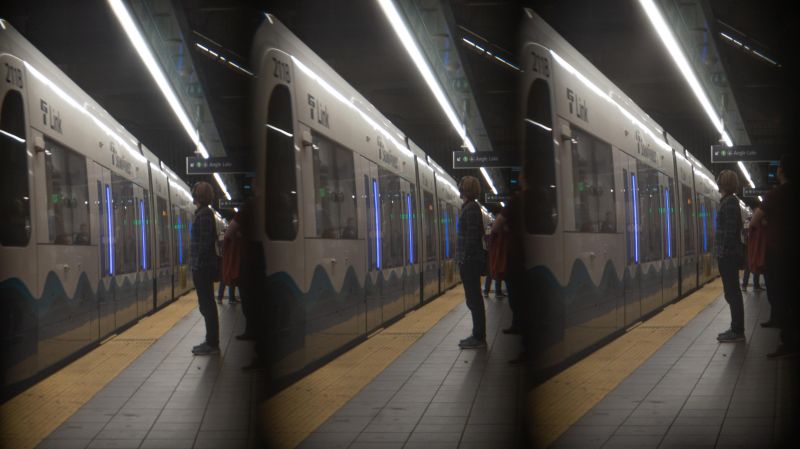Everyone likes a good animated GIF, except for some Hackaday commenters who apparently prefer to live a joyless existence. And we can’t think of a better way to celebrate moving pictures than with a 3D printed trinocular camera that makes digital Wigglegrams a snap to create.
What’s a Wigglegram, you say? We’ve seen them before, but the basic idea is to take three separate photographs through three different lenses at the same time, so that the parallax error from each lens results in three slightly different perspectives. Stringing the three frames together as a GIF later results in an interesting illusion of depth and motion. According to [scealux], the inspiration for building this camera came from photographer [Kirby Gladstein]’s work, which we have to admit is pretty cool.
While [Kirby] uses a special lenticular film camera for her images, [scealux] decided to start his build with a Sony a6300 mirrorless digital camera. A 3D printed lens body with a focusing mechanism holds three small lenses which were harvested from disposable 35 mm film cameras — are those still a thing? Each lens sits in front of a set of baffles to control the light and ensure each of the three images falls on a distinct part of the camera’s image sensor.
The resulting trio of images shows significant vignetting, but that only adds to the charm of the finished GIF, which is created in Photoshop. That’s a manual and somewhat tedious process, but [scealux] says he has some macros to speed things up. Grainy though they may be, we like these Wigglegrams; we don’t even hate the vertical format. What we’d really like to see, though, is to see everything done in-camera. We’ve seen a GIF camera before, and while automating the post-processing would be a challenge, it seems feasible.
















“disposable 35 mm film cameras — are those still a thing?” Yes, they are. Kodak, Fujifilm, and Ilford still make them, though availability can be limited. Kodak and Ilford even make black and white versions!
What don’t exist any more are in-house drugstore development machines. You can still take your cameras to many drugstores for development but they’ll be sent to a central processing lab. But you won’t get the shells back; if you want to harvest those you’ll have to process the film yourself. The black and white cameras would be a good choice because the film is much easier to develop at home.
Thrifty builders might also find old disposable cameras at a flea market or the like. Those may be unused, or they may have been used but never taken in for development. If you just want the lenses it doesn’t matter.
In these cameras normal 35mm film cartridges are used. I think they are dleivered rolled out and with each exposure the exposed part of film is rolled back into the cartridge. So when all exposures are made you can take out the film easily and bring it to the drugstore for processing. Nor need to hand over the “disposable” camra.
Disposable film cameras (almost) always have nearly normal 135 film cassette in them. The spool often (always?) had a crown gear that meshes directly with the film advance wheel, instead of the usual drive mechanism. This means you couldn’t (easily) reload them yourself. You would have to unload the original cassette after exposing it, and tape a new length of film onto the original leader. There are leader retrievers that help you pull the film back out. This would leave you with exposed film outside a cartridge, so you would either have to develop it yourself (easy for B&W, much harder for color) or put it in another cassette to take in for developing.
The film starts out completely unwound. This makes the drive mechanism much more simple, since you only have to move the film in one direction in camera. You don’t have to feed it out between pictures, and rewind it to remove the cassette (or the other way around). It also means that if the camera breaks or is opened before you’ve finished the roll, you lose one or two exposed images, since the rest are safely held in the cassette. Because the camera is loaded in the dark, you don’t lose the frames on the film leader, and can fit a few extra frames on your roll. That’s why disposable cameras usually take 27 frames instead of the standard 24.
“Disposable” cameras were never truly disposable. When you took them in for processing, the lab would open them, take out the cassette, and send the camera back to the manufacturer to refill. It’s also why they were sometimes sold with pre-paid processing and envelopes, to get the camera back to the right manufacturer for reuse.
Just don’t take your film to Walgreens/CVS.. sure you will get prints but they throw away your negatives.. (not shredded). Also they scan your prints at 600 dpi. When I discovered this I made them send back my undeveloped film (35mm test astrophotos) and mailed them to a processor in KC.
Hmm, i wonder if three of those esp32-cam modules would give a comparable or even better result…
Here are some of mine:
http://blog.combicreations.com/steve/2022/10/22/time-for-space-stereo-photography/
They are easy to make using just your phone or any digital camera.
Recently had the same idea and so I started working on it. Got decent results today and will be documenting the project tomorrow! https://hackaday.io/project/188437-wigglegram-esp32-cam
Reminds me of this mid 1980s system featured on That’s Incredible:
https://www.youtube.com/watch?v=MG7H01iqYf8
According to her website, Kirby is a she!
You’re right, my bad.
Good catch, fixed.
You say that, yet there are still “he” and “his” all over the article :P
Just realized there no edit or delete… Also realized I missed the name change right before the he’s and his’ 😂 whoops! :D